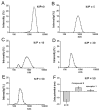PSMA-specific theranostic nanoplex for combination of TRAIL gene and 5-FC prodrug therapy of prostate cancer
- PMID: 26706476
- PMCID: PMC4706473
- DOI: 10.1016/j.biomaterials.2015.11.048
PSMA-specific theranostic nanoplex for combination of TRAIL gene and 5-FC prodrug therapy of prostate cancer
Abstract
Metastatic prostate cancer causes significant morbidity and mortality and there is a critical unmet need for effective treatments. We have developed a theranostic nanoplex platform for combined imaging and therapy of prostate cancer. Our prostate-specific membrane antigen (PSMA) targeted nanoplex is designed to deliver plasmid DNA encoding tumor necrosis factor related apoptosis-inducing ligand (TRAIL), together with bacterial cytosine deaminase (bCD) as a prodrug enzyme. Nanoplex specificity was tested using two variants of human PC3 prostate cancer cells in culture and in tumor xenografts, one with high PSMA expression and the other with negligible expression levels. The expression of EGFP-TRAIL was demonstrated by fluorescence optical imaging and real-time PCR. Noninvasive (19)F MR spectroscopy detected the conversion of the nontoxic prodrug 5-fluorocytosine (5-FC) to cytotoxic 5-fluorouracil (5-FU) by bCD. The combination strategy of TRAIL gene and 5-FC/bCD therapy showed significant inhibition of the growth of prostate cancer cells and tumors. These data demonstrate that the PSMA-specific theranostic nanoplex can deliver gene therapy and prodrug enzyme therapy concurrently for precision medicine in metastatic prostate cancer.
Keywords: Gene therapy; PSMA; Prodrug enzyme therapy; Prostate cancer; TRAIL; Theranostic imaging.
Copyright © 2015 Elsevier Ltd. All rights reserved.
Figures








Similar articles
-
PSMA-targeted theranostic nanoplex for prostate cancer therapy.ACS Nano. 2012 Sep 25;6(9):7752-7762. doi: 10.1021/nn301725w. Epub 2012 Aug 9. ACS Nano. 2012. PMID: 22866897 Free PMC article.
-
Nanoplex delivery of siRNA and prodrug enzyme for multimodality image-guided molecular pathway targeted cancer therapy.ACS Nano. 2010 Nov 23;4(11):6707-16. doi: 10.1021/nn102187v. Epub 2010 Oct 19. ACS Nano. 2010. PMID: 20958072 Free PMC article.
-
Delayed Progression of Lung Metastases Following Delivery of a Prodrug-activating Enzyme.Anticancer Res. 2017 May;37(5):2195-2200. doi: 10.21873/anticanres.11554. Anticancer Res. 2017. PMID: 28476782
-
Radiolabeled enzyme inhibitors and binding agents targeting PSMA: Effective theranostic tools for imaging and therapy of prostate cancer.Nucl Med Biol. 2016 Nov;43(11):692-720. doi: 10.1016/j.nucmedbio.2016.08.006. Epub 2016 Aug 11. Nucl Med Biol. 2016. PMID: 27589333 Review.
-
Prostate-Specific Membrane Antigen (PSMA) Theranostics for Treatment of Oligometastatic Prostate Cancer.Int J Mol Sci. 2021 Nov 9;22(22):12095. doi: 10.3390/ijms222212095. Int J Mol Sci. 2021. PMID: 34829977 Free PMC article. Review.
Cited by
-
TRAIL in the Treatment of Cancer: From Soluble Cytokine to Nanosystems.Cancers (Basel). 2022 Oct 19;14(20):5125. doi: 10.3390/cancers14205125. Cancers (Basel). 2022. PMID: 36291908 Free PMC article. Review.
-
Ocoxin as a complement to first line treatments in cancer.Int J Med Sci. 2021 Jan 1;18(3):835-845. doi: 10.7150/ijms.50122. eCollection 2021. Int J Med Sci. 2021. PMID: 33437220 Free PMC article. Review.
-
Targeted nonviral gene therapy in prostate cancer.Int J Nanomedicine. 2018 Sep 25;13:5753-5767. doi: 10.2147/IJN.S139080. eCollection 2018. Int J Nanomedicine. 2018. PMID: 30310278 Free PMC article. Review.
-
Molecular and functional imaging insights into the role of hypoxia in cancer aggression.Cancer Metastasis Rev. 2019 Jun;38(1-2):51-64. doi: 10.1007/s10555-019-09788-3. Cancer Metastasis Rev. 2019. PMID: 30840168 Free PMC article. Review.
-
111In- and IRDye800CW-Labeled PLA-PEG Nanoparticle for Imaging Prostate-Specific Membrane Antigen-Expressing Tissues.Biomacromolecules. 2017 Jan 9;18(1):201-209. doi: 10.1021/acs.biomac.6b01485. Epub 2016 Dec 21. Biomacromolecules. 2017. PMID: 28001364 Free PMC article.
References
-
- Koo H, Huh MS, Sun IC, Yuk SH, Choi K, Kim K, Kwon IC. In vivo targeted delivery of nanoparticles for theranosis. Acc Chem Res. 2011;44:1018–1028. - PubMed
Publication types
MeSH terms
Substances
Grants and funding
LinkOut - more resources
Full Text Sources
Other Literature Sources
Medical
Miscellaneous

